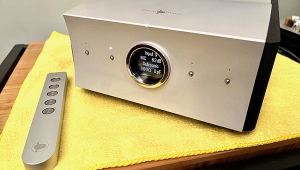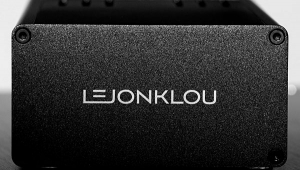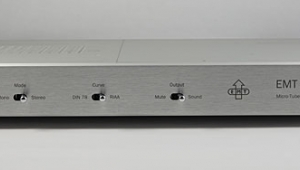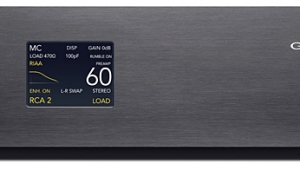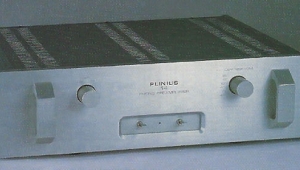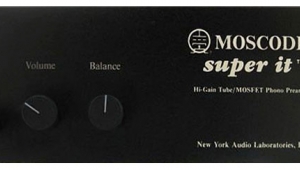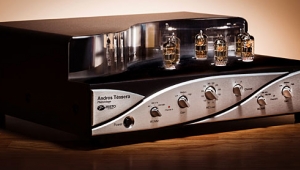| Columns Retired Columns & Blogs |
Balanced Audio Technology VK-P10 phono preamplifier
Some of the most innovative thinking on hybrid circuit design these days seems to come from Russian designers. As a group, they are technically very well educated, pragmatic, and unfettered by American high-end didacticism.

Balanced Audio Technology's Victor Khomenko, late a citizen of Leningrad, emigrated here with his wife Anya in 1979. Most of his working experience has been in the field of instrumentation for the military and aerospace industries. He and soon-to-be partner Steve Bednarski met while pursuing careers at Hewlett-Packard. They found their commonality, high-end audio; Victor built Steve one of his custom amps; they both took deep breaths; the rest, as they say was Balanced Audio Technology.
Technology
The VK-P10 is a versatile, true all-tube, differential, high-current phono stage. Its well-vented case is identical in size to that of BAT's VK-5i remote-control couch-potato preamplifier. (RD, having reviewed the original VK-5 line-level preamp, brought you word of this upgrade in April (Vol.20 No.4, p.245). Suffice to say, it's a terrific piece. The user interface is severely habit-forming!) An on/off toggle switch protrudes from the left of the VK-P10's aluminum faceplate, while a discrete blue power-on LED peers out from the center. After a 45-second soft-start ramp-up with two relay clicks, you're ready for signal.
I was interested to note the polarity switch on the right side of the front panel. With a differential circuit, phase inversion comes almost free. The signal path is the same either way, the only penalty being an additional switch in the signal path.
Around back, the unit sports both single-ended and balanced input jacks, but only XLR outputs. Not to worry; BAT provides the finest XLR/RCA adapters I've ever heard. (Check out my Sidebar interview with Victor for his interesting thoughts on mixing single-ended and balanced equipment.) As for the two types of input, Victor explained, "Jonathan, you know, you'd have a balanced input if the cartridge was a balanced device. But since it only has two leads, the cartridge doesn't know if it's balanced or single-ended. The fact is, you get better noise performance when you connect the cartridge in single-ended fashion. However, we recommend balanced connections from that point on."
The back panel also carries a ground connector, a fuse port, and an IEC receptacle.
Layout
In general terms, the VK-P10 is a fully differential three-stage zero-feedback device with a passive differential RIAA network. Peering into the exposed chassis, I noted that it was efficiently laid out and obviously built to a high standard. Two current-source 6SN7 tubes dominate the boardscape, with two rows of four 6922s each ranked to either side. All tubes are Russian: the big 'SN7s branded "Sovtek."
One of two toroidal transformers is mounted vertically on either side of the front case. (The VK-P10 is dual-mono from the power cord on.) A number of squat black capacitors carpet the forward section of the circuit board, bristling with over 200 Joules of get-up-'n'-go. (That's more than some medium-powered amplifiers, Victor tells me.)
The caps filter and smooth the DC in what Victor describes as a Double-Pi configuration. Pi filters are essentially two caps to ground with a resistor in between. The cap/resistor/cap assembly looks like the sign for Pi. Remove one cap, and you're looking at an L filter! We're demystifying science here.
These two Pi filter stages are linked in series. Post-Pi, as it were, the smoothed DC branches three ways: to the output stage, through an additional L filter to the second stage, and via another L filter to the input stage. Input each side is handled by a single 6922. The second stage—another 6922—functions as a simple differential pair with the 6SN7 providing the current source. This stage boosts the signal and provides buffering for the differential passive RIAA network that follows. Two more 6922s are paralleled together per channel in the output stage.
I've given you the gruesome details regarding circuit topology because it's one of the defining elements in the overall design. You see, many high-end preamps use heavy regulation in their power supplies. But regulation implies feedback, and that's something Victor doesn't care for.
"Throwing feedback in improves measured performance," he explained, "but I simply don't like the way it sounds. You know, it's something like your ideal body weight. Let's say that's 160 lbs..."
- Log in or register to post comments
